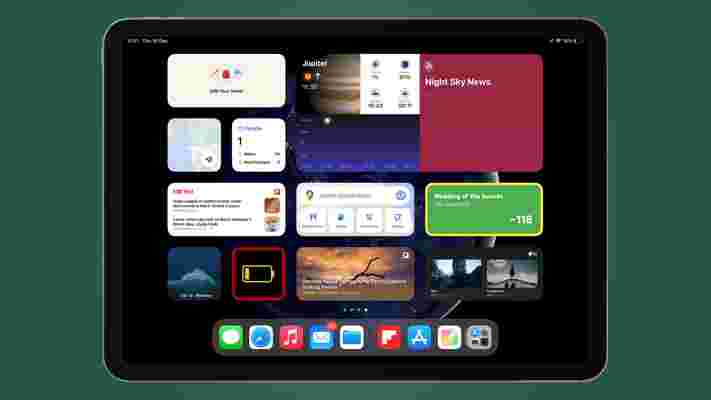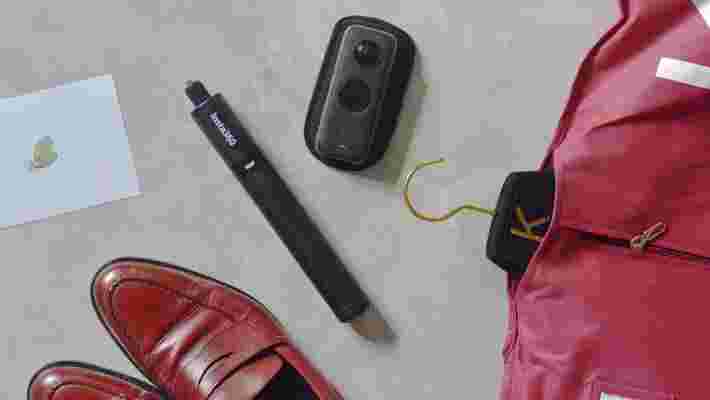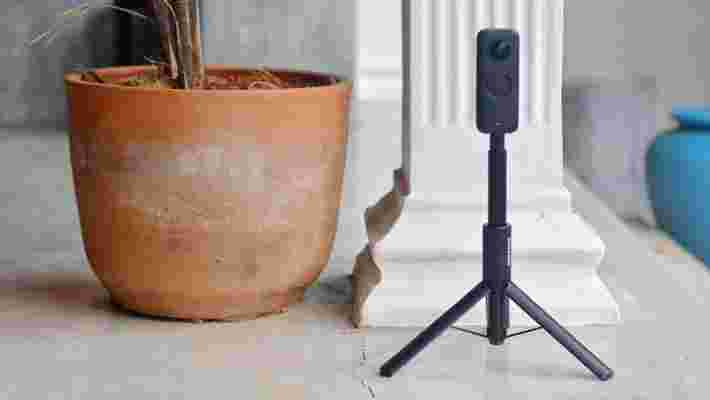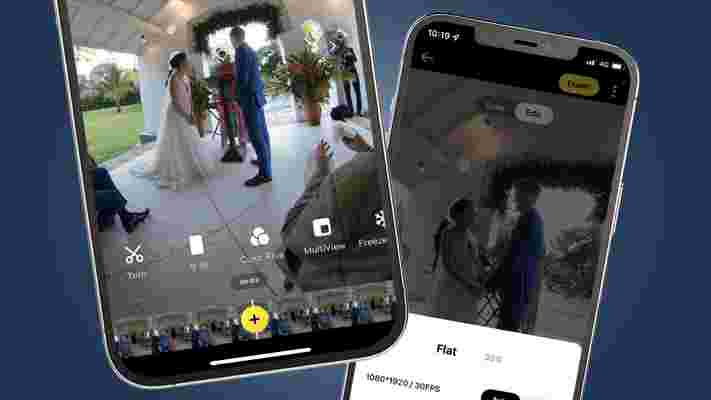When iPadOS 15 was announced back at WWDC 2021, I was disappointed to find that it was more of a catch-up to iOS 14, with widgets on the home screen.
While the new Focus feature and better multitasking options were welcome, they didn't go far enough in improving how I used the iPad at the time. As these updates felt so minor to me, I decided to switch to a MacBook Pro 14-inch (2021) , and I've been happy with it since.
However, with WWDC 2022 confirmed for June 6, there's a good chance we'll see iPadOS 16. Hopefully, we'll see the operating system set itself apart from iOS, with features that are not only exclusive to the iPad but justifies the 'Pro' in iPad Pro.
With this in mind, here are five features that I'd like to see for iPadOS 16.

1. External monitor support
This is a feature that many iPad users have been wanting, myself included when I owned one. While you can connect an iPad to a display, it only mirrors what's being shown on the tablet, and worse, in a resolution that doesn't adapt to the monitor.
We're in a time where completing your work on two or three monitors is normal. You can swap apps and windows between these displays and macOS or Windows 11 handles them fine.
But in iPadOS, that's not possible. Let's see an additional multitasking window show when an iPad is connected to a display. This way, you can swipe an app to another display, and let it display in the full resolution that the monitor is capable of.
2. Redesigned lock screen
There are parts of iPadOS where it looks as though it's an iPhone feature but supersized. Siri was guilty of this for years, where it would cover the entire screen, but thankfully this was resized in a compact menu in iPadOS 13.
The lock screen should be next to benefit from this. While we were given refined notifications in iPadOS 15, there's plenty of space being wasted, especially on the 12.9-inch iPad Pro.
Let's see a widget displayed at least - perhaps weather as the default, followed by the choice of adding another. While you can swipe to the left and have some widgets display, having them show as soon as you wake the screen would be a nice touch.
3. Record more than one person in a call
This has been a bugbear of content creators, especially those who record podcasts. While you're able to take part in calls and group calls thanks to FaceTime, Skype and others, there's been no way to record everyone separately.
This is how many people capture the recordings for a podcast, as it enables audio editors to place separate audio files to make an episode.
Currently, on iPadOS, there's no way of doing this.
So, let's see an easier way to record multiple people on a call and be able to save them all as separate files, ready to edit into a podcast.
This one change could open up the iPad as a portable podcast machine – from recording a guest, to placing the file into Garageband or Ferrite, then saving it as a finished podcast file, ready to upload to a provider.
4. Final Cut
While there are apps like iMovie and Luma Digital that can edit your video projects, some content creators want the extra power and features that an app like Final Cut provides.
This is Apple's pro version of its video editing apps and has only been available on macOS. But with the Mac and iPad both running on Apple Silicon, users have been wishing to see Final Cut on the iPad.
Seeing this as part of iPadOS 16, along with widgets and shortcuts, could really appeal to pro users. And being able to carry on with their Final Cut projects from Mac to iPad would improve workflows, no need to use a different app on an iPad.
5. Better picture-in-picture support
This is a feature that was once exclusive to the iPad, before moving over to macOS, then iOS 15. However, its features have stayed the same since its debut in iOS 9 on iPad. It's time for some improvements.
To have a timeline slider would be a great benefit, as you currently have to go back to the app that's originally playing the video and press the slider to switch to a different part of what's playing.
Another welcome feature would be the ability to place the video anywhere on the display. While you can do that to a point now, the video has been known to place itself below menus or obstructed by an app. On macOS, you can solve this by holding down the command button and dragging the video anywhere on the display.
If these two improvements arrived on iPadOS, there'd be an increase in its use, especially with YouTube's decision to bring the feature to its app for Premium users.
Sleep coach explains when we dream and whether dreams have meaning
Do you wake up sometimes after the most bizarre dream and wonder if it has any meaning? And while we’re on the subject, have you ever wondered what stage of sleep you dream in? As professional sleep coach Beatrix Schmidt , author of The Sleep Deep Method , explains, “there are many misconceptions about sleep, dreams and their connections.
“Our dreams are linked to our thoughts and emotions, both positive and negative. It is important to be curious about dreams, but remember that like our thoughts, dreams are not facts and so do not obsess or stress over them.”
Here Schmidt chats to TechRadar about dreams – at what stage of sleep they happen in, why we dream, and whether dreams have meaning, especially the recurring ones.
What stage of sleep do you dream in?
There are various phases of sleep: REM, rapid eye movement sleep, and non-REM sleep or SWS, slow-wave sleep. Most of your dreaming occurs during REM sleep, although some can occur in SWS.
The most vivid dreams occur in REM sleep where brain wave EEG analysis shows the brain is very active, especially in the hippocampus (the memory area) and amygdala (the emotion, fear and stress response processing area).

“In my practice working with clients who struggle with insomnia, waking up from a sleep stage and remembering dreams can cause a lot of discomfort especially when waking up to them in the middle of the night.” Schmidt reveals.
“As I explain to my clients, it’s not as much about the exact science of dreams but more about how you respond to your experience of dreams.”
Why do we dream? What function do they serve?
The exact role of dreams is unknown. However, as Schmidt says: “Dreams are important as they help us reconcile information. They help us process memories and learn and deal with what happened during the day.”
Like Matthew Walker, author of Why We Sleep , she describes dreams as a “filing of information” from the day, helping us learn and investigate things we read, thought about, saw, and felt that day.
Does dreaming mean you’re getting good sleep?
This is a really common question, but the answer isn’t black and white, says Schmidt. “The connection between great quality sleep and dreaming is not direct. Just because you are dreaming does not mean your sleep is better or worse. Just because you remember your dream does not mean you are sleeping better.
“We always dream – it’s part of natural sleep – we just may not remember it.” Schmidt continues. “Dreaming is not a moment you can choose to ‘catch’ and be in full control over, but think of it more as a part of what happens during sleep, just like your body’s recovery overnight. We remember dreams from when we transition between two sleep phases, but you cannot control this.”

Do dreams have meaning or should we ignore them?
Sigmund Freud, the prominent neurologist, described in his 1953 book, The Interpretation of Dreams , his belief that dreams are a key to access a person’s inner world. He believed dreams showed suppressed emotions and fears. However, says Schmidt, “Dreams seem to have a meaning to us based upon our personal situation, but that does not mean it it is a premonition.
“From my perspective, dreams do not have a direct meaning. Some people see real meaning in dreams and therefore the outcomes may become self-fulfilling prophecies. We have power over what happens in our life, the outcomes and therefore can alter the outcome of our life events.
There may even be a more simple explanation for the specific dreams we have. “If you go to bed with a worry, you are likely to dream about it. For example, if you are worried about a meeting at work going wrong, it is likely you will dream about the meeting at night.” Schmidt reasons. “However, just because the dream happened, it does not mean it will unfold this way.”
Are recurring dreams trying to tell us something?
Many people experience recurring dreams. Often these follow a theme such as flying, falling, losing your teeth or missing an important test. “The purpose of recurring dreams can be that the mind is continuing to entertain or explore a situation or scenario that has not been resolved yet,” Schmidt clarifies.
“Recurring dreams are not always negative – they can be excitement or hopes too. It can be a sign that we need to accept, let go of, wrap up or conclude a positive excitement or negative fear or stress that is persisting in our thoughts.”

“It’s important not to draw too deep meaning from dreams as this can lead to increased anxiousness about sleep or even cause sleep problems,” Schmidt cautions. “Be curious about dreams but not obsessive or overly analytical, and don’t see them as automatic truths.”
What is lucid dreaming and can everyone do it?
Lucid dreaming is when you are aware that you are dreaming and can control the theme and outcomes of the dream. Lucid dreaming occurs in about 4% of dreaming according to LaBerge, 2007 , as your brain cycles through non-REM sleep to REM sleep.
Most of the time lucid dreaming occurs as someone wakes up approximately five hours into deep REM sleep and when conscious, changes their thoughts and goes back to sleep.
But before you set an alarm for half-way through the night, Schmidt strongly warns against it: “I do not recommend deliberately waking yourself up during sleep to try and remember and control the theme of a dream, as this can cause you sleep problems and disrupt your natural sleep patterns.”
“Over analysing your dreams does not help you to directly improve your sleep or reduce anxieties, whether linked to positive or negative emotions.” Schmidt explains. “It is more important to relax and prepare for sleep physically, emotionally, and mentally so that your dreams do not disrupt your sleep or life. It is not about the dream but how you respond to it.
“We need to be relaxed about our dream experiences, so we are not stressed during the day or night and are more able to think logically, learn and process emotions.”
This article is part of TechRadar's Sleep Week 2022 (running from Sunday 13 to Saturday 19 March), a week-long celebration of all things slumber. We'll be bringing you proven techniques and tips to help you sleep better, and have rounded-up all the top-rated tech to transform your sleep.
I swapped my wedding photographer for a 360 camera – and the risk paid off
While preparing for my wedding, one question I didn’t expect to hear so regularly was, “who’s filming the ceremony?” The answer that I gave was equally unexpected: “I’m recording it myself. With a 360 camera.”
But that’s exactly what I did. After the cost of the photography team left us sweating with fear for our financial stability, the idea of shelling out further for a full videography setup was simply out of the question.
Don’t get me wrong: I understand the value – and appreciate the work – of imaging professionals, especially at events as significant as weddings. If money was no object, my wife and I would have loved to have a movie of our big day captured in 4K. I can see it now: the soft focus as we walk down the aisle, the artful bokeh as champagne glasses clink, the slow-mo of me stumbling on the dance floor.

Alas, as for so many couples on the path to marital bliss, money was an object. So instead of breaking the budget in the name of frame rates, I instead had the bright idea to use a 360-degree camera to record every angle of the ceremony.
Fully-charged, positioned on a tripod halfway up the aisle and operated with military discipline by my best man, it still wouldn’t capture the creative angles or full-frame quality that a videographer could. But it would record every word and wiped eye at our wedding, for quite a lot less cash. At least, that was the plan.
Why did I choose a 360 camera?
Having decided to film our own wedding, a 360 camera was the obvious tool for the job. Sure, a standard DSLR or mirrorless camera on a fixed tripod could have captured a clear angle of the ceremony. But in the right position, a 360 camera would offer unrivaled immersion by shooting the entirety of the nuptial scene – audience and all.
More than a spherical novelty, it would also give me unlimited editing options after the fact. I’d be able to crop in on flat frames from anywhere within the resulting 360 footage.

So I could select and export footage of my beautiful wife arriving, then pan the video around to save a clip of my father-in-law simultaneously dabbing his eyes.
And because it would capture the whole spectacle by itself, a 360 camera could be set and left with minimal hassle. Which is the gold standard for any wedding day plan.
The 360 wedding setup
Three contenders vied for the videography job: the GoPro Max , the Insta360 One R Twin Edition and the Insta360 One X2 . Each put forward compelling pitches, but the One X2 won the gig for several reasons.
Its interface is accessible, even with hands made wobbly by wedding nerves. Its understated design wouldn’t distract guests from the main event. It also produces dynamic 360 footage that’s seamlessly stitched, while the smartphone app is one of the most comprehensive for creative editing. Plus it can shoot standard widescreen video at 1440p using one lens. It’s significantly less expensive than a videography team, too – and unlike a videography team, I can take it on the honeymoon.

Cleverly, the One X2 can also remove Insta360’s ‘invisible’ attachments from footage using automatic masking. Fitted atop the '2-in-1 Invisible Selfie Stick + Tripod', for example, the mount magically disappears as if Casper is holding the camera. The stand itself is ideal for wedding duties: much less bulky than a traditional tripod, its flip-out feet and low profile meant it flew under the radar while standing to one side of the aisle.
Completing the package was a microSD card fast enough to cope with the demands of processing 360 footage and large enough to keep recording even if proceedings ran over. On Insta360’s recommendation, I opted for a 64GB SanDisk Extreme Pro V30 A1 card. I also doubled up with a second microSD card and backup battery – the idea being that I could quickly switch in the fresh accessories between the ceremony and the speeches.
My Insta360 One X2 bundle also included a simple but indispensable rubber lens cap. Those big glass eyes are vulnerable to scratches and, with the camera due to stand in wait while setup went on around it, the extra protection made sense.
How well did it work?
On a day with a million moving parts, the Insta360 One X2 was mercifully easy to work with. A few hours prior to proceedings, I was able to enjoy a moment of solitary reflection at the ceremony venue: reflecting on where to position the camera.
The Insta360 One X2 has a neat circular touchscreen, which proved handy for on-the-spot framing later in the evening. But to be sure I had it in the best position for the ceremony, I paired it with my smartphone via Wi-Fi and Bluetooth for a live 360 preview feed through the app. After a bit of panning and shuffling, I settled on a spot at the end of the first row of chairs. This gave the closest thing to a head-on aspect, without obstructing the aisle – or anyone’s sightline.
I opted not to change the camera from its standard settings: full-round 5.7K footage at 30fps is the Insta360 One X2’s best – and with no extreme sports listed in the program, it was just what we needed. I also kept its FlowState stabilization smarts enabled, to counter any swaying of the slender tripod pole if things got breezy.
The walkthrough with my wingman was painless: press the power button, press the record button, wait for the red light. True, we could’ve employed a smartphone to trigger the video, but that would’ve still required the camera to be switched on. Equally, we could’ve used Insta360’s GPS Smart Remote, but that would’ve meant extra expense.
In reality, there was reassurance in the simplicity – and in the physical confirmation that the right buttons had been pushed and the light was blinking. Especially as I would be hiding in a different room, my inner control-freak itching but unable to check the setup for myself.
And it worked without a hitch. It wasn’t my top priority when I made my grand entrance (honest), but it was a relief to glance at the recording light and see that the little 360 camera had everything covered. And because it did, guests could keep their smartphones away and simply enjoy the moment. It also meant we didn’t have the pressure of a second set of barrels bearing down on us, the shutterbugs from the photography team already trained on my every awkward expression.
In a quiet minute after the formalities were concluded, I came back for the camera. Having been left to run for around an hour, it had maxed out its memory card and switched itself off. I swapped out the microSD, reminded myself that now wasn’t the time to review the footage, fitted the backup cell and nipped through to the reception area to position it for the speeches. Thanks to the endorphins and bubbly now in my bloodstream, I was a little less fastidious with positioning it this time. Luckily, the Insta360 One X2 offers champagne-proof accessibility.
How did I edit my 360 wedding video?
One of the main reasons for selecting the Insta360 One X2 was its excellent smartphone app. Available for free, it features a raft of tools for creative tweaking. While it’s possible to save the spherical footage – meaning I can re-live my wedding day at any time by strapping on a set of VR goggles – the more useful export for most people (myself included) is a flat frame taken from within the 360 video.
When you’ve recorded something as important as your wedding, there’s an inherent fear of corrupting or losing the footage. Having suffered a mild heart attack when I couldn’t find the Insta360 One X2 on the morning after the wedding (foiled by my own late-night brainwave to hide it in a shoe), I made sure to back up the files twice before doing anything else – both to a hard drive and to the cloud. Which, given the sheer size of 360 video, required a lot of space and bandwidth.
That file size almost makes hefty demands of a smartphone. There wasn’t enough space on my iPhone X to save the footage to local storage, so I had to stream video from the Insta360 One X2 during the edit. Which pushed the limits of wireless transfer rates – and caused my iPhone to sweat harder than I did at any point on my wedding day.
But stutters aside, the Insta360 app made a potentially overwhelming process into something intuitive. There’s a lot to digest (so many expressions on display) and the task is obviously more involved than if I’d left the editing to a professional outlet.
Even so, the process of exploring the 360 footage, dropping pins to highlight key moments and watching as the app automatically transitions between positions in the resulting edit doesn’t get old. Likewise, the app’s subject-tracking and auto-framing smarts work like magic.
If you’re more of a real-time director, you can set the app to record your path as you pan around the footage. I can never get this quite right, as it requires fingers defter than my own to pinch and zoom smoothly. But because the original video is endlessly editable, I’m enjoying the continued experiment – finding something new each time I rewatch.
Exporting proved straightforward and pretty speedy, even when I was streaming source material from the camera. Color enhancements did lead to longer processing times, but also made for more vibrant results.
What would I have done differently?
Looking at the footage captured by the Insta360 One X2, I’m fundamentally chuffed with the decision to film our own wedding day. The result is an immersive video that we can watch again and again, noticing something different every time we do. Arguably just as important is the fact that capturing it was easy and didn’t interrupt the day.
That said, there were obviously compromises involved. Even with a full sphere of coverage, some moments were missed. For example, while you can see me arriving on a Royal Enfield in front of the ceremony venue (yes, really), it takes place too far from the camera to crop in for a clear shot. Though the Insta360 One X2 shoots at a 5.7K resolution, those pixels are spread across the full 360, so you simply can’t zoom in beyond a certain point.
A second 360 camera was in no way a necessity, but it would have been a nice luxury. Knowing now how simple it was to set up a single Insta360 One X2, an additional camera would’ve introduced minimal extra stress, while giving a welcome second angle of proceedings. Then again, it would’ve meant twice as much footage to download and review.
In truth, the only thing I wish I’d done is record more of the reception. With Insta360’s Extended Edition Selfie Stick, for example, I could’ve captured some drone-like shots of the hopping courtyard dance floor. And if I was a risk-taker, I could have dared to try a spinning slow-mo shot by whipping the Bullet Time Cord around above my head.
But after all the planning that went into our wedding, I also forgive myself for enjoying the party, rather than fiddling around with camera gear. After all, I’ve got a lifetime of wedded happiness to spend doing that.

